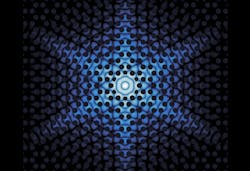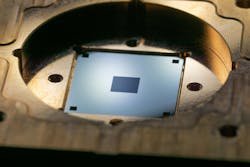Tiny ‘quantum memory’ drum stores data sent via laser as ultrasonic vibrations
In the basement of the University of Copenhagen’s Niels Bohr Institute (NBI) in Denmark, fittingly located beneath what was once Niels Bohr’s office, a group of researchers led by Professor Albert Schliesser built a tiny drum to store data sent via laser as sonic vibrations, which it can then forward as an optical signal whenever required (see video).
NBI’s Center for Hybrid Quantum Networks is working on developing long-lived stationary quantum systems and on-demand single-photon sources, respectively, and the theorists naturally gravitated toward the intriguing idea to explore a quantum memory that can store single photons within the vibration of a membrane.
Mads Bjerregaard Kristensen, a postdoc who worked on the project, was thrilled with this opportunity to combine the topics of photonics and optomechanics while working on his Ph.D.
Quantum memory drum
How does the group’s quantum memory drum work? It features a high-finesse optical cavity and an embedded dielectric membrane—which is visible to the naked eye, although it’s only a few hundred atomic layers thick. And the researchers can control its vibration modes via a phononic crystal.
When the tiny drum gets beaten with a laser, the data-filled light’s signal becomes part of the drum’s vibrations.
“The interaction between photons and phonons within our platform is analogous to Raman scattering of a laser off a vibrating molecule, where the cavity allows us to preferentially drive the anti-Stokes process that interconverts photons and phonons,” Kristensen says. “This is possible when the laser is detuned below cavity resonance by the mechanical frequency, so the anti-Stokes sideband lands on resonance, while the Stokes sideband is suppressed by the cavity susceptibility.”
Schliesser’s group previously developed membrane resonators with long lifetimes, which enables them to convert itinerant optical signals to stationary, long-lived mechanical ones—and back again. “We characterized the efficiency of such an optomechanical memory for photons in detail in the classical regime and argue that operating in only a moderate 10 K cryogenic environment is sufficient for quantum-coherent photon storage,” Kristensen says.
Design work
The group made several tweaks to their previous optomechanical setups for this experiment, which introduced new challenges to be solved.
“First, we redesigned our membranes to work at a higher-order mode so we more easily could select the desired anti-Stokes sideband,” says Kristensen. “Then, we chose to build our memory experiment around a telecom-wavelength laser at 1550 nm to be compatible with existing fiber networks.”
At first, this seemed like a small tweak to the group’s previous experiments powered by titanium sapphire (Ti:sapphire) lasers working around 850 nm. But they didn’t realize how expensive a camera sensitive to this wavelength would be compared to regular silicon complementary metal-oxide semiconductor (CMOS) ones, and they had to rework their alignment procedure for centering the cavity mode on the membrane.
After a bit of trial and error, “we discovered that relying on the magnitude of the ‘overshoot’ when scanning rapidly over a cavity in reflection gave a quick in situ proxy for the linewidth of the cavity,” Kristensen says. “This, in turn, works as a proxy for centering of the cavity mode because any misalignment gives rise to increased optical losses as the beam diffracts off the phononic crystal holes.”
The laser locking approach they opted to use “is quite cool, although a little technical,” Kristensen says. “It’s very indicative of the step-by-step process of experimental research. The problem we had to address was how to keep track of the cavity resonance while switching off the laser when storing photons as phonons.”
Their first thought was to use a second, weaker laser, locked on resonance, to avoid perturbing the mechanics. “One flaw with this strategy is that this second laser would overlap spectrally with any signal we want to store,” Kristensen says. “It could work for bright coherent states, but would preclude any single-photon experiments. Instead, we locked the cavity resonantly to the second, weaker laser, which is locked at a variable frequency offset near the cavity free spectral range from the other laser.”
Since the free spectral range of the cavity is around 26 GHz, the group had to figure out how to conveniently do feedback with such a fast signal. “We settled on downmixing the beat note of the two lasers to a signal within the megahertz range, which necessitated a signal generator capable of such fast signals,” Kristensen says. “Everything finally fell into place with a 4x frequency multiplier circuit so we could use a more readily available synthesizer, and we were able to freely turn the laser interacting with the membrane on and off at will.”
Mechanical systems are quantum memory contenders
From a research perspective, the main takeaway of the group’s work is mechanical systems have matured to a point where they can start to contend with other quantum memory platforms such as atomic ensembles or crystals doped with rare-earth ions.
Not needing to store information within a particular atomic or ionic transition and being free to choose which wavelength to work with makes the optomechanical method extremely versatile. And while their experiment is by no means simple, it’s less complex than experiments involving trapping and cooling of atoms.
“I’m fascinated by the notion of doing quantum physics with mechanical oscillators, even more so when they’re large enough to see with the naked eye,” says Kristensen. “Beyond this almost-philosophical notion, I really enjoy solving the practical problems we encounter inside a quantum optics lab—it was a beautiful moment when we got the whole lock-chain working.”
Quantum comms applications
The main application of this research is quantum communications, in which certain protocols ensure secure communication between two parties by relying on quantum physical phenomena such as superposition and entanglement.
“By comparing measurement outcomes from a sequence of shared pairs of entangled particles, the sender and receiver can detect if the communication was intercepted and, accordingly, whether it’s useful as an encryption key for a sensitive message,” says Kristensen.
This relies on distributing pairs of entangled particles, such as photons, to the sender and receiver, who may be far apart. “Since quantum signals are subject to the same loss as classical ones but can’t be amplified, ‘quantum repeater’ methods tackle this problem by subdividing the distance into manageable segments, with quantum memories at each stop along the way,” Kristensen says. “By first entangling neighboring nodes, we can entangle the two end nodes, where the sender and receiver sit, now sharing a pair of entangled particles.”
Since entangling all the intermediate steps takes time, “it requires quantum memories that can simultaneously maintain their state if you don’t disturb them, be read out when you like, and are compatible with existing telecom networks,” Kristensen says.
Up next: Increase bandwidth of mechanical memory
The next step for the group is to increase the bandwidth of their mechanical memory, which currently is a limiting factor, at around a kilohertz.
“Even with a range of optimizations, the limit of the membrane-based platform is around a few tens of kilohertz,” says Kristensen. “We’re working on nanoscale mechanical resonators in photonic crystals, where confined gigahertz-frequency mechanical modes couple to a photonic crystal cavity. With these high-frequency devices we aim to reach higher bandwidths, and faithfully capture single photons.”
In September, Kristensen will continue his quantum memory research in a different platform as a postdoc at Chalmers University of Technology in Gothenburg, Sweden.
FURTHER READING
M. B. Kristensen, N. Kralj, E. C. Langman, and A. Schliesser, Phys. Rev. Lett., 132, 100802 (Mar. 5, 2024); https://doi.org/10.1103/physrevlett.132.100802.
About the Author
Sally Cole Johnson
Editor in Chief
Sally Cole Johnson, Laser Focus World’s editor in chief, is a science and technology journalist who specializes in physics and semiconductors.



